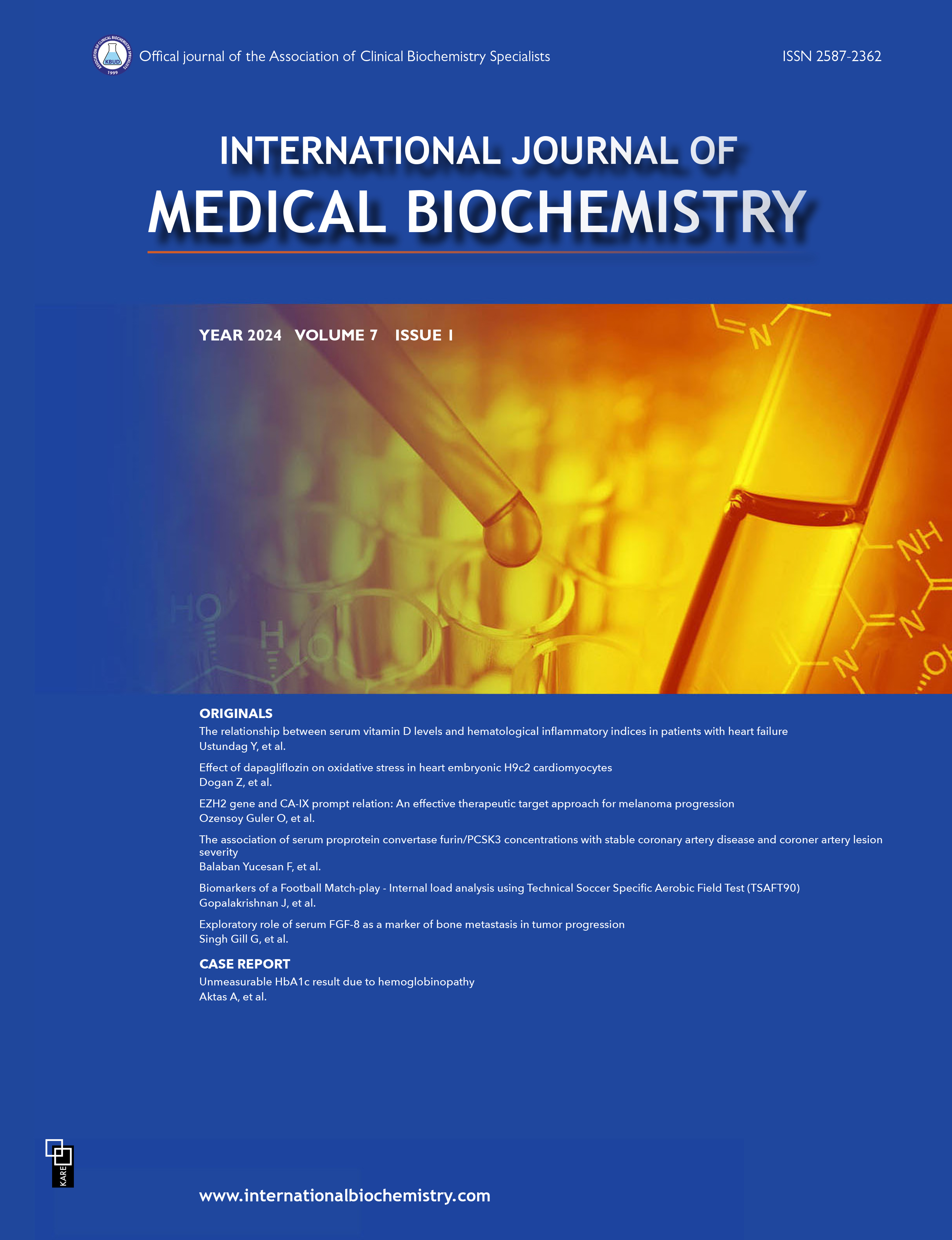Volume: 1 Issue: 2 - 2018
| ORIGINAL INVESTIGATION | |
| 1. | The evaluation of measurement uncertainty of HbA1c and its effect on clinical decision levels Kubranur Unal, Gokce Filiz Atikeler doi: 10.14744/ijmb.2017.76486 Pages 53 - 56 INTRODUCTION: The prevalence of diabetes mellitus (DM) is increasing all over the world. Hemoglobin A1c (HbA1c) is one of the diagnostic tests for DM. But is the HbA1c analysis result accurate and absolute? Uncertainty of measurement is a quality parameter of measurement results, and characterizes the dispersion of the values attributed to a measured quantity. The aim of this study was to estimate the measurement uncertainty (MU) of HbA1c and retrospectively re-evaluate patient results with respect to the estimation of uncertainty and to suggest a solution for results that are close to cut-off level. METHODS: The results of 10212 patients who had an HbA1c analysis performed in our laboratory in 2016 were retrospectively reviewed. The HbA1c levels were measured using a high performance liquid chromatography method. The uncertainty of measurement of the serum HbA1c level was estimated according to the Eurachem/Co-operation on Traceability in Analytical Chemistry Guide CG 4. RESULTS: The measurement uncertainty (95% confidence interval) of HbA1c was estimated to be ±4.6%. When measurement uncertainty was taken into account, the acceptable range for the 6.5% value typically used to diagnose DM was between 6.2% and 6.8%. It was observed that the results of 1555 patients were affected by uncertainty values. DISCUSSION AND CONCLUSION: Medical laboratories must produce the necessary data and analytical results in order to achieve the correct interpretation and use of the results. A test result is not sufficiently powerful without an assessment of its reliability. The interpretation of values that are close to cut-off levels may change when evaluated with the uncertainty of measurement. Therefore, reporting HbA1c analysis results with the estimation of the MU is important to illustrate the true limits and the level of confidence. |
| 2. | An evaluation of efficiency in an emergency laboratory by turnaround time Muhammed Fevzi Kilinckaya, Çigdem Yucel, Turan Turhan doi: 10.14744/ijmb.2018.98698 Pages 57 - 61 INTRODUCTION: Accuracy, precision, timeliness, and authenticity are the 4 pillars of efficient laboratory services. Clinical biochemists generally overlook timeliness as an important attribute. However, turnaround time (TAT) is usually regarded by clinicians as the benchmark of laboratory performance. TAT can be classified by tests: priority, population served, etc. The aim of the current study was to both evaluate and compare the TAT of the test panels used in the emergency laboratory of Ankara Numune Training and Research Hospital. METHODS: The TAT for tests carried out in the emergency laboratory in 2016 was recorded. The TAT limit for each analyte was determined by the hospitals quality control department. Routine biochemistry, arterial blood gas, troponin, erythrocyte sedimentation rate, complete blood count, beta-human chorionic gonadotropin, coagulation panel, and urinalysis tests were evaluated. Samples were grouped by admission time, day, and staff on duty. Samples that exceeded the TAT limit were determined and compared in terms of sample receipt time, day, and staffing. Statistical analysis was performed using SPSS for Windows, Version 15.0 (SPSS Inc., Chicago, IL, USA). P<0.05 was considered statistically significant. RESULTS: A total of 286,577 samples were analyzed in 2016 in this laboratory. The TAT of 30,129 samples exceeded the established time limit. The mean TAT of the staff who worked a day shift on weekdays was significantly higher than that of other shifts, with the exception of arterial blood gas (ABG) testing (p=0.000 for all panels). The mean TAT of the staff who worked a night shift on weekdays and weekends was statistically different, excluding coagulation (p=0.08) and ABG (p=0.09) tests. DISCUSSION AND CONCLUSION: It is strongly recommended that all of the staff who work in the laboratory be sufficiently informed and educated about TAT. Additionally, evaluation of TAT should be taken into consideration in the routine workflow of laboratories. |
| 3. | Comparison of SST and RST tube biochemistry parameter results in emergency laboratory Sebnem Tekin Neijmann, Alev Kural, Zeynep Levent Cirakli, Asuman Gedikbasi, Halil Dogan doi: 10.14744/ijmb.2017.33042 Pages 62 - 64 INTRODUCTION: The goal of the hospital emergency laboratory is to provide quick and accurate test results. With the permission of emergency department patients who required laboratory test results, blood samples were collected in 2 different types of tubes: the standard serum separator tube (SST) and the rapid serum tube (RST) (SST Advance II and Vacutainer RST; Becton Dickinson and Co., Franklin Lakes, NJ, USA) and the results were compared. METHODS: Blood samples were collected from 75 adult patients into RST and SST tubes via routine phlebotomy. Both tubes were centrifuged according the instructions for obtaining serum, and then each tube was tested for the level of alanine aminotransferase, alkaline phosphatase, amylase, aspartate aminotransferase, gamma-glutamyl transferase, lactate dehydrogenase, lipase, total creatinine kinase, creatinine kinase-muscle/brain enzyme, albumin, glucose, calcium, chloride, creatinine, potassium, sodium, total and direct bilirubin, total protein, and urea with an Abbott Architect c16000 (Abbot Diagnostics, Inc., Lake Forest, IL, USA) analyzer and biochemical methods. Statistical calculations were performed with the NCSS 2007 program for Windows (NCSS, LLC, Kaysville, UT, USA). RESULTS: When compared with the SST tube sample results, the RST sample results were clinically equivalent or clinically acceptable. The results were evaluated within a 95% confidence interval. The level of statistical significance was established at p<0.05. DISCUSSION AND CONCLUSION: RSTs do not require a waiting period for clotting, thereby decreasing the turn-around time by nearly 30 minutes. This can lead to increased laboratory efficiency and improved patient management in emergency departments. |
| 4. | Evaluation of biochemistry laboratory quality indicators according to the national Laboratory Error Classification System Medine Alpdemir, Mehmet Fatih Alpdemir, Aslihan Temiz doi: 10.14744/ijmb.2017.35229 Pages 65 - 71 INTRODUCTION: The national Laboratory Error Classification System (LECS) was developed by the Turkish Ministry of Health in 2015 to improve the quality processes of laboratories and enhance patient safety. This study was an evaluation of laboratory processes and quality indicators (QIs) in biochemistry laboratories according to the LECS criteria. METHODS: This retrospective study included 4757 samples of a total of 649,001 samples collected between October 1, 2015 and December 30, 2016 and classified according to the LECS. The data regarding the number and type of rejected samples were obtained from the laboratory information system of Balıkesir State Hospital. Laboratory processes were also analyzed according to the LECS categories and counted on a monthly basis. The data were expressed as percentages. RESULTS: The rate of error in the pre-, intra-, and post-analytical phase was 81.7%, 1.7%, and 16.6%, respectively. Overall, the most common error type was a clotted sample (0.28%). The primary location of error was the emergency service (25.6%). The time intervals during which the most errors occurred were 8: 00-12: 00 and 12: 00-16: 00 (30%). The professional group that made the most errors was the nurse group (64.6%). DISCUSSION AND CONCLUSION: Different QIs have been used in clinical laboratories in Turkey and in the world in recent years to comply with the requirements of accreditation standards. In the present study, QIs were evaluated according to the LECS. These indicators provide a means to compare the performance of individual laboratories. These results may contribute to future laboratory test procedures and reduce error rates. |
| 5. | Endothelial lipase 584C/T gene polymorphism in coronary artery disease in Elazig population: a pilot study Solmaz Susam, Necip Ilhan, Nevin Ilhan, Mehmet Akbulut doi: 10.14744/ijmb.2018.69775 Pages 72 - 76 INTRODUCTION: Coronary artery disease (CAD) is one of the major causes of death in the world. It can be a result of environmental or genetic factors. A single nucleotide polymorphism (SNP) is a variation of 1 nucleotide sequence in any region of the genome, which may cause susceptibility to the disease. Therefore, SNPs have been proposed as ideal markers in disease association studies. Endothelial lipase (EL) is a protein of the triglyceride lipase family that plays an important role in high-density lipoprotein (HDL) metabolism. The EL gene has a common 584C/T polymorphism, but it is unclear whether this polymorphism is associated with HDL-cholesterol levels or CAD. The purpose of this study was to investigate the relationship between the EL 584C/T gene polymorphism, HDL level, and the risk of CAD in residents of Elazig province. METHODS: The population of this study consisted of 78 patients with angiographically confirmed CAD and 81 healthy controls. Genotyping for the 584C/T polymorphism was performed using the polymerase chain reaction-restriction fragment length polymorphism technique. RESULTS: The frequency of the CT, CC, and TT genotypes was 40.74%, 56.8%, and 2.46%, respectively, in the control group, and 66.67%, 30.37%, and 2.56%, respectively, in the CAD group. The Hardy-Weinberg value was p<0.05 for the control group and p>0.05 for the CAD group. No significant association was found between the 584C/T variant and HDL level. The T allele frequency was higher in the CAD group than among the controls. DISCUSSION AND CONCLUSION: It was concluded that the T allele was associated with a risk of CAD in Elazig province, independent of the HDL-cholesterol level. |
| CASE REPORT | |
| 6. | Preoperative evaluation of EDTA-dependent pseudothrombocytopenia before lumbar disc herniation surgery: A case report Mustafa Sahin, Unsal Savci, Havva Hande Keser Sahin doi: 10.14744/ijmb.2018.21939 Pages 77 - 79 Ethylenediaminetetraacetic acid-dependent pseudothrombocytopenia (EDTA-PTCP) is an in vitro phenomenon characterized the clustering of platelets following the use of EDTA as an anticoagulant, leading to a decreased analyzer platelet count in a complete blood count (CBC). This report is a description of the case of a 47-year-old male patient admitted to a neurosurgery clinic with the complaints of back and leg pain. A neurological examination and lumbar magnetic resonance imaging revealing extruded disc herniations led to a decision to perform surgery. Thrombocytopenia was detected in the preoperative testing of the patient. The CBC was reanalyzed using citrate. Peripheral blood smears of the patient collected using citrate and EDTA were compared. Thrombocytopenia was not detected in a CBC of the citrated sample and the peripheral smear did not reveal platelet clusters. Pseudothrombocytopenia was considered, as the anamnesis, physical examination findings, and coagulation tests of the patient were not consistent with thrombocytopenia. In conclusion, EDTA-PTCP was diagnosed during the preoperative evaluation of the patient. |
| REVIEW | |
| 7. | Biomarkers for acute kidney injury Dildar Konukoglu doi: 10.14744/ijmb.2018.09719 Pages 80 - 87 Acute kidney injury (AKI) is associated with both a number of adverse outcomes and with morbidity and mortality. Therefore, early diagnosis of AKI is very important. Several novel AKI biomarkers have been found and studied. Markers include impaired filtration barriers, reduced tubular reabsorption, increased release of tubular proteins due to cell damage and/or activation of inflammatory cells, and the release of activation products in response to injury. Neutrophil gelatinaseassociated lipocalin, kidney injury molecule 1, interleukin-18, liver-type fatty acid-binding protein, cystatin C, tissue inhibitor of metalloproteinase-2, and insulin-like growth factor-binding protein 7 markers appear to be useful; however, the clinical uses of AKI biomarkers are not yet well defined and the number of clinical trials is limited. Additionally, analytical validation of tests for AKI markers is also required. Therefore, measurement of the daily quantity of urine and determination of blood urea and creatinine levels are most often used for both diagnosis and classification of AKI in clinical practice. |
| LETTER TO THE EDITOR | |
| 8. | Letter to the Editor: Relationship between glycemic control and serum uric acid level in acute myocardial infarction Mustafa Sahin, Unsal Savci, Havva Hande Keser Sahin doi: 10.14744/ijmb.2018.80774 Pages 88 - 89 Abstract | Full Text PDF |
| 9. | Author`s Reply Zeynep Levent Cirakli Page 89 Abstract | Full Text PDF |



















